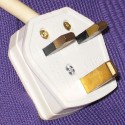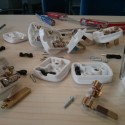 Looking back on my own time in secondary school I remember, in terms of useful practical outcomes, precisely one lesson. Of course there are many more which influenced and shaped me, but only one that I regularly and knowingly draw on. It was Year 9 Science, and for reasons I did not understand at the time, the wonderful Dr. Myatt taught us how to wire an electrical plug. Nothing earth shattering, but something that I have needed to do many times, and which really taught me a lot about electrical safety.
Looking back on my own time in secondary school I remember, in terms of useful practical outcomes, precisely one lesson. Of course there are many more which influenced and shaped me, but only one that I regularly and knowingly draw on. It was Year 9 Science, and for reasons I did not understand at the time, the wonderful Dr. Myatt taught us how to wire an electrical plug. Nothing earth shattering, but something that I have needed to do many times, and which really taught me a lot about electrical safety.
With a lesson in hand for two of my Year 9 ICT classes this week, I decided to take a leaf out of Dr. Myatt’s book and teaching plug wiring as a one-off lesson. Hopefully they will take away as much from this experience as I did from the lesson that inspired it.
Resources
In planning the lesson I needed to obtain the following:
- 20x fused, replacement 3-prong plugs
- 15x medium size Philips head screwdrivers
- 5x flat head screw drivers (which I did not use in the end)
- 10x scissors (good quality is key, more would be useful. I chose not to use wire strippers as I wanted kids to use simple household tools for the job)
- 1x roll of electrical tape
- 1x 10m length of electrical wire
- 1x square 9V battery
Some of this was scrapped from existing school supplies, other items were purchased new. In the end, we spent a meagre HKD $260, which I thought was very good value for money. Before the lessons began I cut the cable into 50cm lengths, and the electrical tape into 9cm segments. I arranged the tools and equipment at a table that the whole class could gather around.
Why Bother?
I try to start all lessons and units with what I call “The Pitch”: one or more reasons for students to be interested in the lesson. In this case, I mentioned that students will most likely end up buying devices in different countries, and that this skill will help them avoid having to constantly find travel adapters in order to their various appliances. I also mentioned the joy of being able to solve such household problems independently, and the time and money this can save.
Safety
In approaching this subject my primary concern was that of safety: making sure the students took the activity seriously, understood the risks and would not come to any harm. To get the point across I asked for a brave volunteer to press a 9v battery against their tongue. With a new battery this can be quite a shock, so I used an older one, with a little less juice in it. The students were apprehensive, but eventually a brave volunteer came forward. He took a risk, experienced some discomfort, and entertained his classmates. I then explained that this 9v battery was less than 5% of the strength in our 220v sockets. To really get the attention of the students I showed the first 30 seconds of the macabre video below (warning, people die, it is unpleasant):
A few kids laughed, which I quickly put a stop to. Most appreciated the awesome power that we were dealing with, and it was a good chance to discuss that fact that you never touch someone being electrocuted without insulation, in order to avoid becoming a victim yourself. From here we looked at the new plugs, and I asked them to consider why the earth pin is the longest (so that the plug is earthed before any power enters the system). We also discussed the purposes of fuses, and I showed them the location of the fuse within their MacBook chargers.
The Process
I then gave the class a quick demonstration of the process involved in rewiring a plug (watch this video if you want more detail, or don’t want to risk a live demo):
- Unscrew the top case.
- Remove the cuff/cable clamp (which holds the electrical cord in place)
- Strip around 3-4 cm (depending on the plug design) from the end of the outer layer of the cord.
- Cut the earth wire (green and yellow) to fit the available space, and then strip away 5mm of insulation from the end of the earth wire.
- Attach the earth wire to the earth pin.
- Fix the electrical cord to the plug using the cuff.
- Repeat Step 5. for the remaining wires (remember, the BLue cable goes in the Bottom Left, and the BRown cable in the Bottom Right).
- Make sure there are no lose wires, and the case fits snuggling on top.
- Screw the case into place
As a final safety precaution, I had students insulate one end of their cables with electrical tape, before starting. The idea being that if anyone did plug in their finished product (which I explicitly forbade), the risk of electrocution would be greatly reduced.
Hands On
All of this had taken around 15 minutes, and the students were keen to get started. They almost all seemed to enjoy the process, and those who generally do not enjoy ICT seemed more motivated than usual. Many found it hard, tiring and frustrating, which I was secretly thrilled with: nothing like struggling through things to appreciate what you have. The class was active, with a lot of questions from students, and plenty of quality control on the teacher’s part. After 50 minutes working time, about a third of students had finished, whilst the rest were very close. This gave us 5 minutes for students to tidy up, leaving me to disassemble the work before the next class came in (this did take a while). Some students opted to stay behind during break to finish up their work, which was great to see.
Final Thoughts
Ideally, with more time, I would have had all students finish the assembly, and then disassemble someone else’s work (for informal peer assessment purposes). I would also have liked to have some power packs and light bulb, so we could have tested the plugs. However, this was beyond what I had time and budget to arrange. Overall, both lessons went very well, the kids enjoyed themselves, and I will definitely add this to the curriculum for future years.
Credits: British Plug image by Secretlondon on Wikipeida





